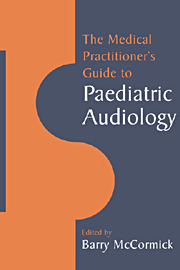Book contents
- Frontmatter
- Contents
- List of contributors
- Preface
- Acknowledgement
- 1 Introduction to hearing problems in childhood
- 2 Causes of deafness
- 3 Behavioural tests
- 4 Pure tone audiometry
- 5 Objective hearing tests
- 6 Middle-ear measurements
- 7 The management of otitis media with effusion
- 8 Management of unilateral hearing loss
- 9 Management of sensorineural hearing loss
- 10 Cochlear implants
- Index
7 - The management of otitis media with effusion
Published online by Cambridge University Press: 01 October 2009
- Frontmatter
- Contents
- List of contributors
- Preface
- Acknowledgement
- 1 Introduction to hearing problems in childhood
- 2 Causes of deafness
- 3 Behavioural tests
- 4 Pure tone audiometry
- 5 Objective hearing tests
- 6 Middle-ear measurements
- 7 The management of otitis media with effusion
- 8 Management of unilateral hearing loss
- 9 Management of sensorineural hearing loss
- 10 Cochlear implants
- Index
Summary
Scope of the chapter
Otitis media with effusion is the most common cause of hearing impairment and reason for elective surgery in children. In most cases no specific treatment is required and the important role of the medical practitioner is to identify the small number of cases that warrant treatment or onward referral. This chapter aims to provide background information on the condition and a practical guide to assist medical practitioners in this task.
Introduction
Otitis media with effusion (OME) is a normal finding in children following an upper respiratory tract infection and the majority of OME resolves spontaneously. Only a small minority of approximately 4.7 per 1000 children come to surgery in Britain. While many have focused their attention on the appearance of the drum or tympanometric tracing, it is the history that is all-important in the management of OME.
Hearing screening attempts to identify children whose hearing loss is sufficient to affect their language and speech development. It is of primary importance to ensure that children with a sensorineural hearing loss are not missed, and every effort should be made to try and find these children as early as possible, although logistically this is difficult. This group has to be differentiated from the large number of children with OME. Many children will need following up as a result of screening. The system varies from district to district depending on the resources available but follow-up may be undertaken by a variety of staff.
- Type
- Chapter
- Information
- The Medical Practitioner's Guide to Paediatric Audiology , pp. 75 - 86Publisher: Cambridge University PressPrint publication year: 1995



